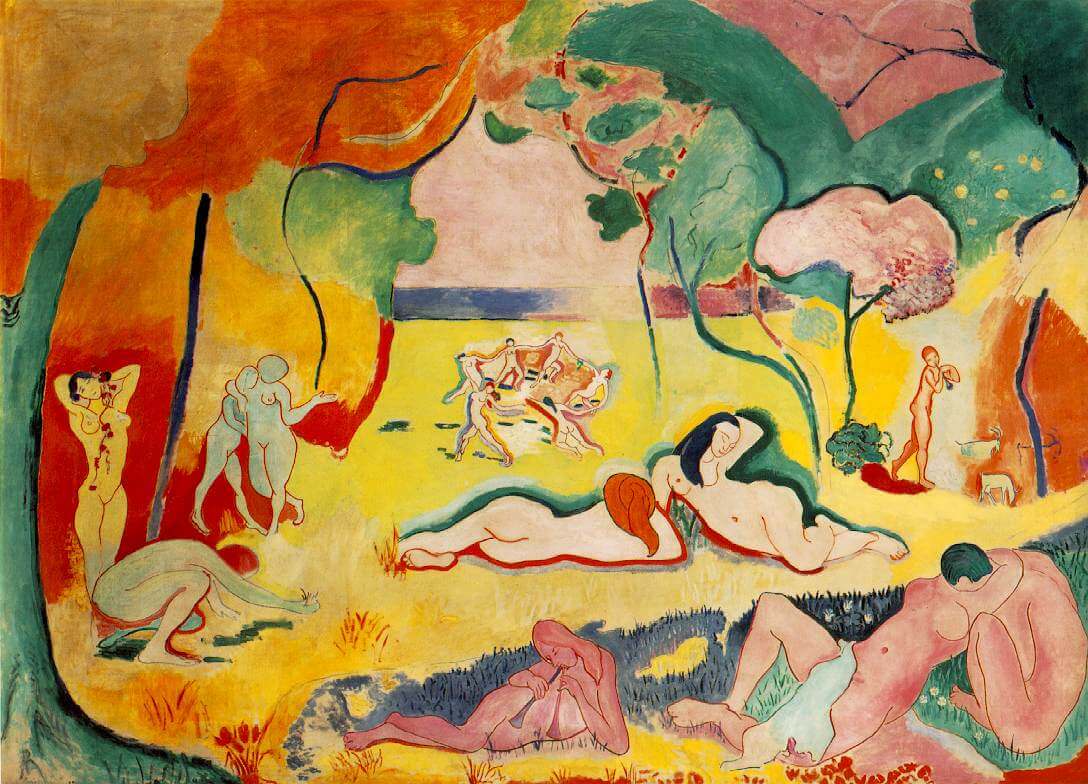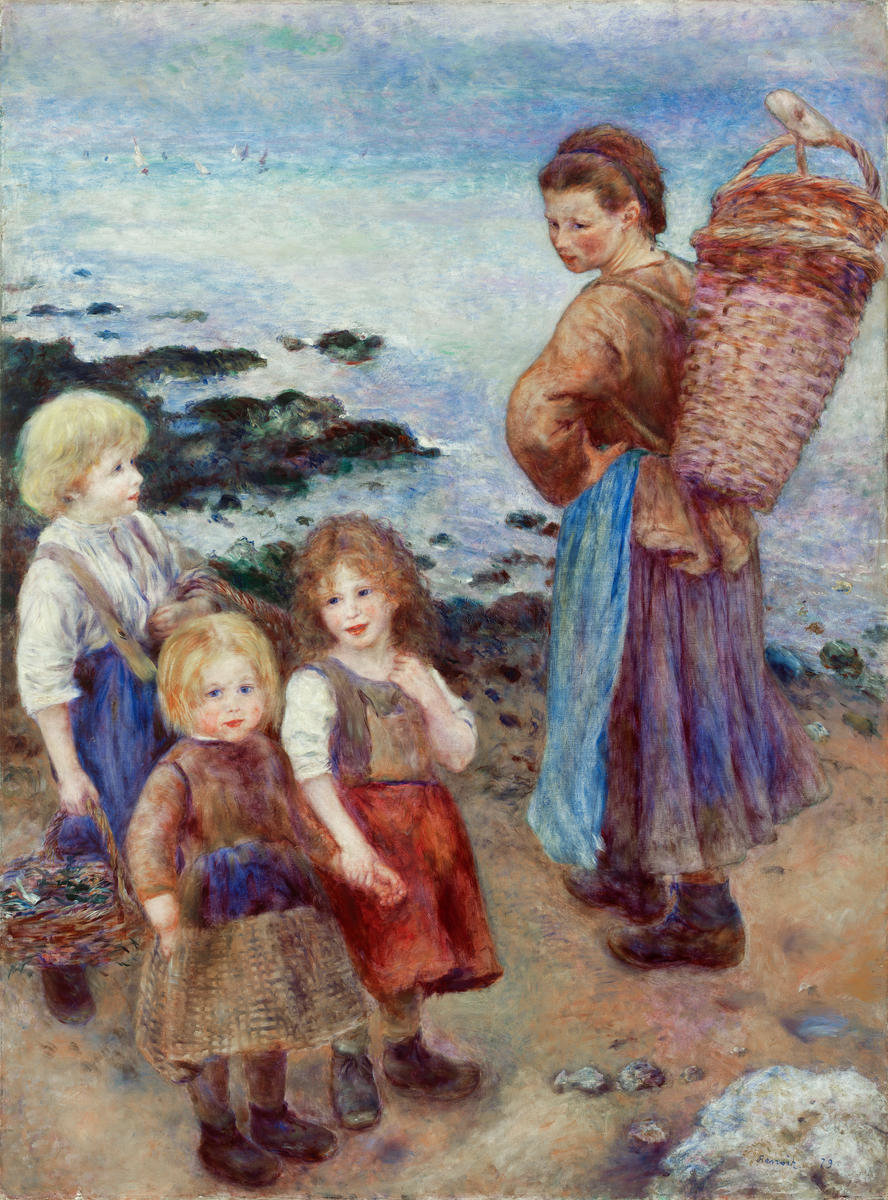June 23–September 8, 2024
In summer 2024, the Barnes Foundation will present Matisse & Renoir: New Encounters at the Barnes, an exhibition featuring a selection of renowned canvases from its modern European art collection. Co-curated by curator Cindy Kang and assistant curator Corrinne Chong, this exhibition—including approximately 35 iconic works by Henri Matisse and Pierre-Auguste Renoir from the second floor of the Barnes collection galleries—reflects the expansion of the Barnes’s educational program, emphasizing the historical and cultural context of the works.
On view in the Roberts Gallery from June 23 through September 8, 2024, Matisse & Renoir: New Encounters at the Barnes is sponsored by Comcast NBCUniversal.
Tracing the creative development of two foundational artists of European modernism, this exhibition will display Matisse and Renoir paintings from the same time period in proximity, such as Matisse’s The Joy of Life (1905–6) and Red Madras Headdress (1907), and Renoir’s Leaving the Conservatory (1876–77) and Mussel-Fishers at Berneval (1879). Creating space for new conversations between works—a critical aspect of education, research, and public access—it will give audiences a rare opportunity to temporarily view these paintings in new contexts and juxtapositions. While this exhibition is on view, the second floor of the Barnes collection will be closed for a floor refinishing project. Following the exhibition, the paintings will return to their original locations in the collection galleries.
“We are delighted to present this exhibition featuring two artists that Dr. Barnes collected voraciously—Matisse and Renoir—and allow visitors and students the opportunity to experience these iconic works from a fresh perspective. Seeing beloved works in new conversations for the first time is sure to be an enriching and revelatory occasion,” says Thom Collins, Neubauer Family Executive Director and President. “Like the original educational experience when Dr. Barnes and Violette de Mazia moved works of art to create new juxtapositions for students, we are enthusiastic about the enhanced educational opportunities that will result from seeing Barnes paintings in new contexts.”
Beginning with a gallery dedicated to Renoir, the exhibition presents a select overview of his work, from impressionist landscapes to his late portraits of rosy-hued women. Renoir significantly influenced the next generation of modern French artists, including Matisse, who considered him a leading colorist and figure painter. Contemporaneous with Renoir’s late paintings, Matisse’s fauve works are highlighted in the next gallery, reunited in a rare display that offers visitors the space to appreciate the expansive nature of his radical and vibrant canvases. By 1917, Matisse was painting in the South of France and began visiting Renoir at his home in Cagnes to show the older artist his recent work. Inspired by this moment of direct conversation between the artists, the exhibition juxtaposes Matisse’s Three Sisters triptych (1917) with three of Renoir’s monumental multifigure compositions. The final gallery, anchored by Matisse’s Music Lesson (1917), explores the play between interior and exterior space in his window scenes, which remained a site of formal and thematic experimentation through his late work.
“Through this exhibition, visitors will discover how a particular place or moment in time shaped the work of each artist and consider the possibility of their shared creative ideas,” say the co-curators. “We hope this temporary presentation will inspire audiences to view these well-known works in a new light with a renewed sense of appreciation.”
The exhibition will feature approximately 35 major works, including paintings and one sculpture, from the second floor of the Barnes collection. Highlights include:
- Henri Matisse, Le bonheur de vivre or The Joy of Life (1905–6): This monumental canvas, which once hung in the famous collection of Gertrude and Leo Stein, is one of the watershed paintings in the history of European modernism. When Matisse first exhibited it in Paris in 1906, audiences were shocked by the bold colors, the jarring shifts in scale, and the distorted anatomies.

- Matisse, The Music Lesson (1917): Matisse set this portrait of his wife, daughter, and two sons in the living room of their family home in Issy-les-Moulineaux, France. While the children are occupied with the piano, Madame Matisse is seen through a large open window sitting in the garden, as if the exterior space was an extension of the living room. Music played an important role in the Matisse household; the artist himself was an accomplished violinist. Perhaps the violin resting in the foreground of this family portrait is Matisse's way of including himself in the picture.
- Matisse, Red Madras Headdress (1907): The model for this painting was Amélie Matisse, the artist's wife, who posed frequently for her husband in some of the most revolutionary canvases of the early 20th century. When Matisse first exhibited this picture in 1907, it was not received very well by critics. Matisse deliberately challenges the conventions of portraiture by distorting his subject's body and focusing instead on color and pattern.

- Pierre-Auguste Renoir, Leaving the Conservatory (1876–77): Renoir uses subtle body language to convey the flirtatious exchanges among a group of young Parisians gathered outside a music school. One man gently nudges his friend into conversation with a woman holding a scroll of paper, likely a piece of sheet music. The artist arranged the seemingly random grouping carefully, using members of his bohemian circle as models. While the painting dates to Renoir’s impressionist period, its large scale suggests that he may have intended it for the Salon.
- Renoir, Mussel-Fishers at Berneval (1879): During a visit to the Normandy coast, Renoir painted this idyllic scene of a peasant family gathering mussels. Images of fisherfolk were popular at the Salon, but Renoir deviates from the theme by focusing on the children rather than the adult. Consistent with his other portraits of children, the artist rejoiced in painting the young harvesters’ rose-flushed cheeks and apricot-hued flesh, but their disheveled hair and ragged clothing hints at their labor.
- Renoir, The Seine at Argenteuil (1888): In 1888, Renoir spent a leisurely yet productive summer at the home of the impressionist artist and patron Gustave Caillebotte in Petit Gennevilliers, France. This canvas presents a view from the south bank of the Seine toward the resort town of Argenteuil, concealed by the avenue of trees along the riverside. Departing from the technical experimentations that characterized his landscapes of the same period, Renoir returns to the bold color contrasts and loose, broken brushwork that marked his impressionist canvases of the mid-1870s.
ABOUT THE CURATORS
Cindy Kang, PhD, is curator at the Barnes. She is a specialist in modern European art and particularly focuses on the relationship between painting and decorative arts in late 19th- and early 20th-century France. At the Barnes, she co-curated Marie Laurencin: Sapphic Paris (2023–24), curated Marie Cuttoli: The Modern Thread from Miró to Man Ray (2020), and served as managing curator for the Barnes presentations of Berthe Morisot: Woman Impressionist (2018–19) and Renoir: Father and Son / Painting and Cinema (2018). Additionally, she commissioned the exhibition Water, Wind, Breath: Southwest Native Art in Community (2022) and co-led the institution’s land acknowledgment process. Kang previously held curatorial and research positions at the Frick Collection, the Metropolitan Museum of Art, the Nelson-Atkins Museum of Art, and the Bard Graduate Center, and was a scholar-in-residence at the Getty Research Institute. She received her PhD from the Institute of Fine Arts, New York University.
An art historian and educator from Toronto, Corrinne Chong, PhD, is assistant curator at the Barnes. Since her appointment at the Barnes, she has supported the exhibitions Alexey Brodovitch: Astonish Me (2024), Marie Laurencin: Sapphic Paris (2022–23), and Modigliani Up Close (2022–23). She has also taught courses, including Hearing Painting, Seeing Music and The Symbolist Realm: Music, Art & Poetry. Previously, she worked at the Art Gallery of Ontario, Toronto, where she developed the exhibition Delacroix and Faust: The Good, the Bad, and the “Ugly” (2022) and served as a key member of the curatorial team for Early Rubens (2019–20). As a former classroom teacher, Chong is deeply committed to art education and interdisciplinary pedagogy. She holds degrees in art history and education from the University of Toronto and a doctorate in art history from the University of Edinburgh, where she also pursued word and music studies.



